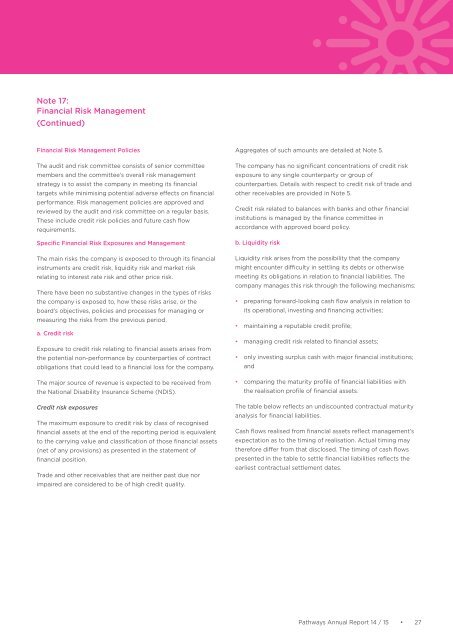2015 Pathways Annual report
2015 Pathways Annual report
2015 Pathways Annual report
Create successful ePaper yourself
Turn your PDF publications into a flip-book with our unique Google optimized e-Paper software.
Note 17:<br />
Financial Risk Management<br />
(Continued)<br />
Financial Risk Management Policies<br />
The audit and risk committee consists of senior committee<br />
members and the committee’s overall risk management<br />
strategy is to assist the company in meeting its financial<br />
targets while minimising potential adverse effects on financial<br />
performance. Risk management policies are approved and<br />
reviewed by the audit and risk committee on a regular basis.<br />
These include credit risk policies and future cash flow<br />
requirements.<br />
Specific Financial Risk Exposures and Management<br />
The main risks the company is exposed to through its financial<br />
instruments are credit risk, liquidity risk and market risk<br />
relating to interest rate risk and other price risk.<br />
There have been no substantive changes in the types of risks<br />
the company is exposed to, how these risks arise, or the<br />
board’s objectives, policies and processes for managing or<br />
measuring the risks from the previous period.<br />
a. Credit risk<br />
Exposure to credit risk relating to financial assets arises from<br />
the potential non-performance by counterparties of contract<br />
obligations that could lead to a financial loss for the company.<br />
The major source of revenue is expected to be received from<br />
the National Disability Insurance Scheme (NDIS).<br />
Credit risk exposures<br />
The maximum exposure to credit risk by class of recognised<br />
financial assets at the end of the <strong>report</strong>ing period is equivalent<br />
to the carrying value and classification of those financial assets<br />
(net of any provisions) as presented in the statement of<br />
financial position.<br />
Trade and other receivables that are neither past due nor<br />
impaired are considered to be of high credit quality.<br />
Aggregates of such amounts are detailed at Note 5.<br />
The company has no significant concentrations of credit risk<br />
exposure to any single counterparty or group of<br />
counterparties. Details with respect to credit risk of trade and<br />
other receivables are provided in Note 5.<br />
Credit risk related to balances with banks and other financial<br />
institutions is managed by the finance committee in<br />
accordance with approved board policy.<br />
b. Liquidity risk<br />
Liquidity risk arises from the possibility that the company<br />
might encounter difficulty in settling its debts or otherwise<br />
meeting its obligations in relation to financial liabilities. The<br />
company manages this risk through the following mechanisms:<br />
• preparing forward-looking cash flow analysis in relation to<br />
its operational, investing and financing activities;<br />
• maintaining a reputable credit profile;<br />
• managing credit risk related to financial assets;<br />
• only investing surplus cash with major financial institutions;<br />
and<br />
• comparing the maturity profile of financial liabilities with<br />
the realisation profile of financial assets.<br />
The table below reflects an undiscounted contractual maturity<br />
analysis for financial liabilities.<br />
Cash flows realised from financial assets reflect management’s<br />
expectation as to the timing of realisation. Actual timing may<br />
therefore differ from that disclosed. The timing of cash flows<br />
presented in the table to settle financial liabilities reflects the<br />
earliest contractual settlement dates.<br />
<strong>Pathways</strong> <strong>Annual</strong> Report 14 / 15 • 27


